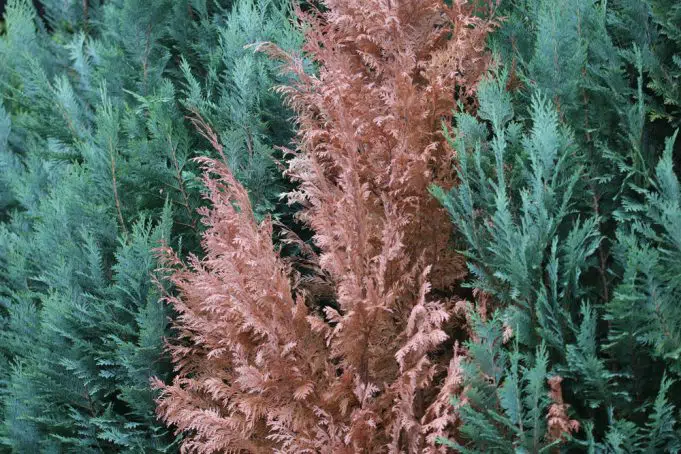Thuja is one of the most popular hedge plants. It not only grows quickly, but also forms a dense screen. Occasionally, especially when autumn comes, the conifer begins to turn brown from the inside. It is a recurring phenomenon that does not harm the plant. It becomes a problem only when the brown areas expand and the tips of the shoots change color.
Discoloration in winter
The Occidental Tree of Life, as the Thuja is also called, originally comes from the region of Canada or the north of the USA. So it is used to extreme temperatures and can adapt to them. This is exactly what the shrub does when it starts to turn a brownish color from the inside in the fall. The plant is then in winter mode, where it can no longer take care of all parts so well.
It can also perform less photosynthesis due to the limited light available. Precisely those parts of the plant that are inside then lose their green color, because they get little sun anyway and thus cannot p
If the thuja hedge turns brown inside in autumn or winter, this is initially a normal process that is not a problem for the plant. It becomes a problem only when the discoloration spreads to the tips of the shoots, or the plant begins to shed the scaly leaves.
Note: Especially wild varieties such as Thuja occidentalis or Thuja plicata are prone to this discoloration. Modern cultivars such as Brabant or Columna are not as prone to discoloration
Danger from salt
Thuja hedge is often located adjacent to a road. In this case, brown discoloration from the inside should be observed quite closely. Like many other conifers, thuja is very sensitive to salt and reacts, among other things, with brown leaves and shoots. These form mainly in the lower area starting from the inside and then spread to the shoot tips. Especially in very snowy or icy winters, where there is a lot of salting, this causes problems for the Thuja hedge.
The following measures should be taken if the Thuja has been damaged by salt:
- Generously hose down the conifer with water so that the salt is washed off
- Water the hedge well, which will shift the salt to deeper layers
- cut off parts of the plant that are dead on frost-free days
- in case of deep cuts into the wood, seal them
Tip: If there is a possibility to draw a small drainage ditch, the conifer can be relieved a little, as part of the salt water is diverted away
Overfertilization
Many gardeners like to fertilize a little too well. Especially mineral fertilizers such as blue grain behave in the soil like road salt. The mineral fertilizer increases the salt concentration in the thuja hedge, which can cause brown discoloration.
As an immediate countermeasure, you should significantly reduce the amount of fertilizer. Subsequently, watering can be increased again, but without waterlogging forming. As a result, similar to salt, the mineral fertilizer is flushed into deeper layers and the concentration in the plants normalizes.
However, gardeners cannot avoid a vigorous pruning even in this case. The tips are dead and also can not regenerate. In this case, it is necessary to make room for other branches to cover the spots.
Drought
Thuja hedge is much better equipped for cold temperatures and suffers accordingly when it is very hot in the summer or the rainfall is absent. In this case, the conifer first begins to turn yellowish from the inside, and then it turns brown to the tips.
A quick remedy is to water the hedge well and thoroughly. Watering should always be done close to the ground. Dry summers are especially problematic for older hedges. Here it can be quite useful if they are subjected to a strong pruning on a not so hot day. This way, the plant will have to take care of fewer side shoots, which will also save you watering water.
Tip: To prevent the soil around the thuja from drying out too quickly, you can cover the soil around it. For this purpose, bark mulch is suitable, which protects the soil from drying out
However, gardeners cannot avoid a vigorous pruning even in this case. The tips are dead and also can not regenerate. In this case, it is necessary to make room for other branches to cover the spots.
Root rot
There are different diseases that can cause thuja to turn brown. However, these can be quickly identified, as the discoloration is primarily from the outside to the inside. Only in the case of root rot, the thuja hedge also begins to turn brown from the inside.
Root rot is a fungal disease that gardeners can not do much. Root rot spreads very quickly and causes the plant to die within a season, so you need to act quickly.
Countermeasures to root rot:
- Reduce watering of the hedge
- dig up affected plants
- dispose of the plant in the residual waste
- treat neighboring plants with a suitable fungicide as a precautionary measure
- Check neighboring plants regularly and react immediately in case of further infestation


